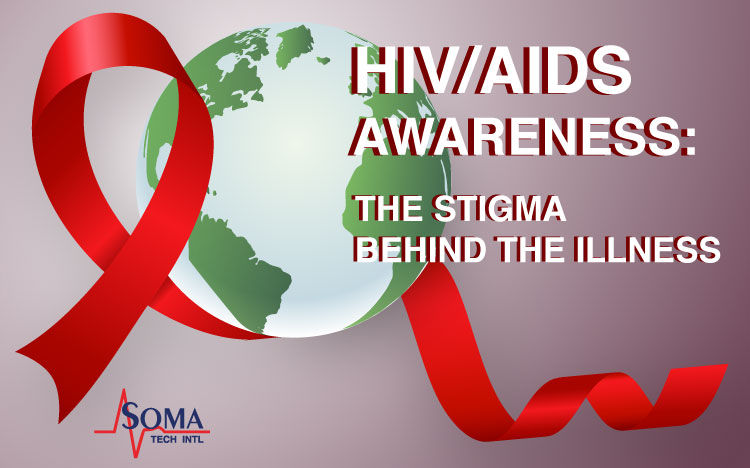HIV/AIDS Awareness: The Stigma Behind the Illness
December 6, 2022
- What is HIV/AIDS?
- How is HIV Spread?
- How Do I know if I have HIV?
- The 3 Stages of HIV
- HIV, AIDS, and Stigma
What is HIV/AIDS?
HIV stands for Human Immunodeficiency Virus, which is a virus that attacks the body’s immune system. Our bodies are full of white blood cells because it makes up our immune system, HIV finds these white blood cells and makes replicas of themselves while also killing the white blood cell. This is how HIV spreads through a person’s body and contaminates the rest of the cells. As a result, HIV weakens your immune system and makes you more susceptible to infections, sickness, etc. AIDS stands for Acquired Immunodeficiency Syndrome, which in simpler terms is the most severe stage of HIV (Stage 3). As of right now, there is no cure for HIV but there are treatments that help control it to keep you and your partner safe.
How is HIV Spread?
HIV is passed from person to person, so a person of any age, sex, ethnic group, religion, sexual orientation, etc. can get HIV. It can be spread through blood, semen, vaginal fluid, or breast milk from a person who has HIV. The majority of people get HIV from sexual relations or from sharing needles, syringes, and other drug injection equipment. HIV can also be transmitted from a mother to her baby, however, it has become less common because of the advances in HIV prevention and treatment.
How Do I know if I have HIV?
The only way to know if you have HIV is by getting tested. You should get tested for STDs, in general, every year at your physical. Getting tested after a new sexual partner is also very important. You can’t tell if a person has HIV by looking at them, some even have no symptoms. Many people have HIV and don’t even know they carry the virus and can still give it to others if they are not aware. The best way to keep yourself safe is by getting tested regularly and practicing safe sex.
The 3 Stages of HIV
There are three stages of HIV. If you have HIV and don’t get treatment, you can go through all three stages. However, advances in the medical industry have come out with treatments that help slow and even prevent the progression of this disease. Because of the prevention against HIV, stage three HIV is less common today than it was in earlier years of HIV.
Stage 1: Acute HIV Infection
- A large amount of HIV is in their blood and is highly contagious.
- The majority have flu-like symptoms.
- Getting tested is the safest thing to do to know for sure.
Stage 2:Chronic HIV Infection
- Also known as asymptomatic HIV infection.
- HIV is still active and continues to spread throughout the body.
- People may not show symptoms or get sick but can still transmit HIV.
- If HIV treatment is started, it may never progress into stage 3.
- Without treatment, this stage can last about a decade, but eventually, the amount of HIV in the blood goes up and moves into stage 3.
Stage 3: Acquired Immunodeficiency Syndrome (AIDS)
- The most severe stage of HIV infection.
- People with AIDS have a high viral load and can transmit HIV easily to others.
- Aids badly damages your immune system, which may result in an increasing number of infections or illnesses.
- Without HIV treatment, people with AIDS typically survive for about 3 years.
HIV, AIDS, and Stigma
There is a huge stigma around people with HIV and AIDS. A stigma refers to irrational and negative attitudes, behaviors, and judgments toward people living with HIV or AIDS. This stigma works its way into acts of discrimination in all parts of society, including healthcare, education, the justice system, families, and communities. Some populations are disproportionately affected by HIV and are affected by this stigma due to their gender, sexual orientation, gender identity, race, ethnicity, drug use, and sex work. The stigma surrounding this disease not only harms individuals living with this virus but entire communities. Some examples of the stigma around HIV in AIDS include:
- A healthcare professional refusing to provide care or services to a person with HIV or AIDS.
- Refusing casual contact with someone living with HIV.
- Socially isolating individuals because they are HIV positive.
Negative stigma against AIDS and HIV can affect the emotional well-being and mental health of people living with the virus, too. Many will internalize the stigma until they develop a negative self-image of themselves. They also may hide their diagnosis out of fear of being judged. This can result in discouraging people from getting tested, getting treatment, or staying in care. To get rid of this stigma, we must be able to talk openly about HIV and AIDS, raise awareness and educate the public about this disease. Many famous people have also come out and shared their diagnoses with the world to spread awareness. Some of these include:
- Magic Johnson: Professional basketball player whose diagnosis made headlines.

- Freddie Mercury: Lead singer of the world-famous band Queen.

- Keith Haring: Famous artist known for his commercial art and working with big clothing brands such as Adidas.

- Eazy-E: Rap artist and co-founder of the group N.W.A. who has some of the most influential rap albums in history.

- Arthur Ashe: First black man to win the U.S. Open and Wimbledon titles for tennis. He acquired HIV through a blood transfusion and came out about his diagnosis shortly after Magic Johnson.

Many of these famous stars have become advocates for HIV and AIDS. They have donated money to charities that work with people living with this illness and others that have been working on new treatments. Many have also started foundations to raise awareness and help others get the treatment they need. While this illness can be scary, with advances in medicine and treatments, it is possible to live a long and healthy life with HIV. Our fight against HIV and AIDS has just started, will you join us?
Explore Other Blog Items By Category
Recent Posts


EKG vs ECG | What’s the Difference Between ECG and EKG?

